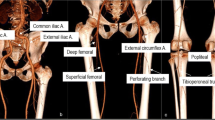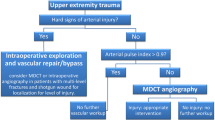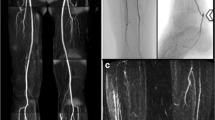Abstract
Aim
The aim of this study was to evaluate the feasibility and effectiveness of multi-slice computed tomography (MSCT) angiography for the assessment of traumatic lesions involving the arteries of the lower limbs.
Materials and methods
Forty-seven patients with suspected arterial post-traumatic lesions of lower limbs underwent MSCT angiography (4 × 2.5-mm collimation, 3-mm slice width). The standards of reference were: digital subtraction angiography (DSA; patients with inconclusive/doubtful or positive MSCT angiography indicating a need for intravascular treatment), surgical findings (patients with positive MSCT angiography indicating a need for surgery), or clinical/investigational follow-up (patients with negative MSCT angiography and no need for further diagnostic procedures or surgery).
Results
All CT exams were technically adequate. Sensitivity, specificity, and overall diagnostic accuracy of MSCT angiography were 96.3, 90, and 93.6%, respectively, relative to the reference of standard findings. In 44 out of 47 patients, MSCT angiography allowed a correct continuation of the diagnostic work-up.
Conclusion
MSCT angiography is a reliable fast tool for diagnosing traumatic vascular lesions, providing results comparable to DSA.


Similar content being viewed by others
References
Geuder JW, Hobson RW II, Padberg FT Jr et al (1985) The role of contrast arteriography in suspected arterial injuries of the extremities. Ann Surg 51:89–93
Burger IM, Murphy KJ, Jordan LC et al (2006) Safety of cerebral digital subtraction angiography in children: complication rate analysis in 241 consecutive diagnostic angiograms. Stroke 37:2535–2539
Hyare H, Desigan S, Nicholl H et al (2006) Multi-section CT angiography compared with digital subtraction angiography in diagnosing major arterial hemorrhage in inflammatory pancreatic disease. Eur J Radiol 59:295–300
Willmann JK, Baumert B, Schertler T et al (2005) Aortoiliac and lower extremity arteries assessed with 16-detector row CT angiography: prospective comparison with digital subtraction angiography. Radiology 236:1083–1093
Bynoe RP, Miles WS, Bell RM et al (1991) Noninvasive diagnosis of vascular trauma by duplex ultrasonography. J Vasc Surg 14:346–352
Meissner M, Paun M, Johansen K (1991) Duplex scanning for arterial trauma. Am J Surg 161:552–555
Yaquinto JJ, Harms SE, Siemers PT et al (1992) Arterial injury from penetrating trauma: evaluation with single-acquisition fat-suppressed MR imaging. Am J Roentgenol 158:631–633
Soto JA, Munera F, Morales C et al (2001) Focal arterial injuries of the proximal extremities: helical CT arteriography as the initial method of diagnosis. Radiology 218:188–194
Soto JA, Múnera F, Cardoso N et al (1999) Diagnostic performance of helical CT angiography in trauma to large arteries of the extremities. J Comput Assist Tomogr 23:188–196
Rosner B (1995) Fundamentals of biostatistics. Duxbury, New York, NY, pp 420–426
Karlstrom L, Bergqvist D (1997) Effects of vascular surgery on amputation rates and mortality. Eur J Vasc Endovasc Surg 14:273–283
Rubin GD, Shiau MC, Leung AN et al (2000) Aorta and iliac arteries: single versus multiple detector-row helical CT angiography. Radiology 215:670–676
Lips DL, Vacek JL (1999) Catheter-based methods for managing peripheral vascular disease: which types of occlusive disease are most amenable? Postgrad Med 106:69–73, 77–78, 80–82
Reimer P, Landwehr P (1998) Non-invasive vascular imaging of peripheral vessels. Eur Radiol 8:858–872
Rubin GD, Zarins CK (1995) MR and Spiral/Helical CT imaging of the lower extremity occlusive disease. Surg Clin North Am 75:607–619
Waugh JR, Sacharias N (1992) Arteriografic complications in the DSA era. Radiology 182:243–246
Puls R, Knollmann F, Werk M et al (2001) Multi-slice spiral CT: 3D CT angiography for evaluating therapeutically relevant stenosis in peripheral arterial occlusive disease. Rontgenpraxis 54:141–147
Ofer A, Nitecki S, Linn S et al (2003) Multidetector CT angiography of peripheral vascular disease: a prospective comparison with intraarterial digital subtraction angiography. AJR Am J Roentgenol 180:719–724
Ota H, Takase K, Igarashi K et al (2004) MDCT compared with digital subtraction angiography for assessment of lower extremity arterial occlusive disease: importance of reviewing cross-sectional images. AJR Am J Roentgenol 182:201–209
Catalano C, Fraioli F, Laghi A et al (2004) Infrarenal aortic and lower-extremity arterial disease: diagnostic performance of multi-detector row CT angiography. Radiology 231:555–563
Martin ML, Tay KH, Flak B (2003) Multidetector CT angiography of the aortoiliac system and lower extremities: a prospective comparison with digital subtraction angiography. AJR Am J Roentgenol 180:1085–1091
Willmann JK, Mayer D, Banyai M et al (2003) Evaluation of peripheral arterial bypass grafts with multi-detector row CT angiography: comparison with duplex US and digital subtraction angiography. Radiology 229:465–474
Laissy JP, Pernes JM (2004) Imaging of the lower limb arteries: when, how and why? J Radiol 85:845–850
Karcaaltincaba M, Akata D, Leblebicioglu G et al (2004) MDCT angiography of the extremities in pediatric patients: initial experience. AJR Am J Roentgenol 183:189–192
Jakobs TF, Wintersperger BJ, Becker CR (2004) MDCT-imaging of peripheral arterial disease. Semin Ultrasound CT MR 25:145–155
Patel AV, Marin ML, Veith FJ, Kerr A, Sanchez LA (1996) Endovascular graft repair of penetrating subclavian artery injuries. J Endovasc Surg 3:382–388
Uflacker R, Elliott BM (1996) Percutaneous endoluminal stent-graft repair of an old traumatic femoral arteriovenous fistula. Cardiovasc Intervent Radiol 19:120–122
Author information
Authors and Affiliations
Corresponding author
Rights and permissions
About this article
Cite this article
Iezzi, R., Cotroneo, A.R., Pascali, D. et al. Multi-slice CT (MSCT) angiography for assessment of traumatic lesions of lower limbs peripheral arteries. Emerg Radiol 14, 389–394 (2007). https://doi.org/10.1007/s10140-007-0656-3
Received:
Accepted:
Published:
Issue Date:
DOI: https://doi.org/10.1007/s10140-007-0656-3




